Youth Football Online
The Promotion & Instruction of Youth Football
0 items
-$0.00
Home / Understanding the 4-2-5 Defense | Strengths and Weaknesses
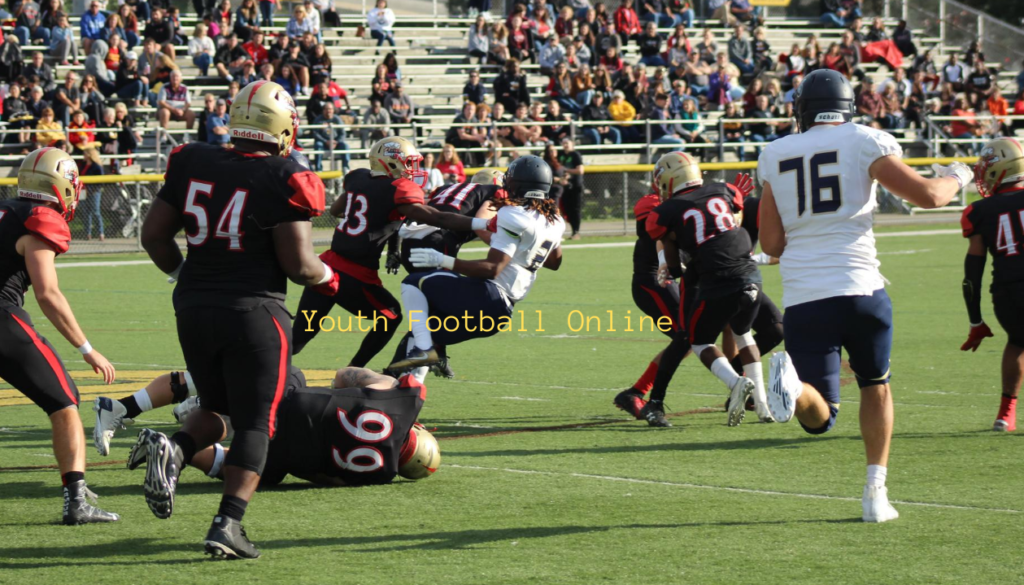
The 4-2-5 Defense features four defensive linemen, two inside linebackers, and five defensive backs ( 2 CBs, 1 FS, and 2 OLB/S hybrids which we call Dogs). The strength of this defense is that it includes five defensive backs. This will allow you to stop the run, apply pressure on pass plays, and it will allow you to easily align against any formation the offense comes out in. I know many youth football coaches will hear ‘five defensive backs’ and automatically think you can’t stop the run on the youth level. That couldn’t be further from the truth- we’ll get into that. Understanding the 4-2-5 Defense begins with knowing the strengths and weaknesses of the defense.
In this article, we will discuss (jump to desired section):
I get asked a lot- how can you stop the run with 5 defensive backs? First off, the overhang / hybrid OLB/S player isn’t a true defensive back- he is a combination of a linebacker and safety. They will be two of the best players on the field. Secondly, there are several different stunts and blitzes that can be utilize to compensate for being “undersized”. But we’ll get into great depth on how to defend the run out of the 4-2-5 Defense in a second below.
The 4-2-5 Defense gives your defense the ability to easily align against spread formations. It will also allow you to maintain a strong box against the run and give you pursuit defenders at the point of attack. Most importantly, it will provide you with a highly flexible, easy-understandable, and athlete friendly approach to defending multiple offensive formations. Spread offenses are become more and more popular on the youth level and this defense will allow you to combat these spread formations.
DT: Defensive Tackle
DE: Defensive End
Dogs (D): Overhang Linebackers (safety / linebacker hybrid)
Rip (R): Right Inside Linebacker
Leo (L): Left Inside Linebacker
CB: Cornerback
FS: Free Safety
When it comes to understanding the 4-2-5 Defense it all begins with alignment! Regardless of how good your players are if you aren’t aligned properly you will be in trouble. It’s a good rule of thumb to make sure that your defense is never outnumbered or out-leveraged to any side.
Strong Right (defense’s right)
On Strong Right we will put the strong side DE in 7 and the strong side DT in a 3 technique. Strength is to the (Y) which is a TE.
Strong Left (defense’s left)
On Strong Left we will put the strong side DE in 7 and the strong side DT in a 3 technique.
Alignment vs. Spread Formation
vs. 2×2
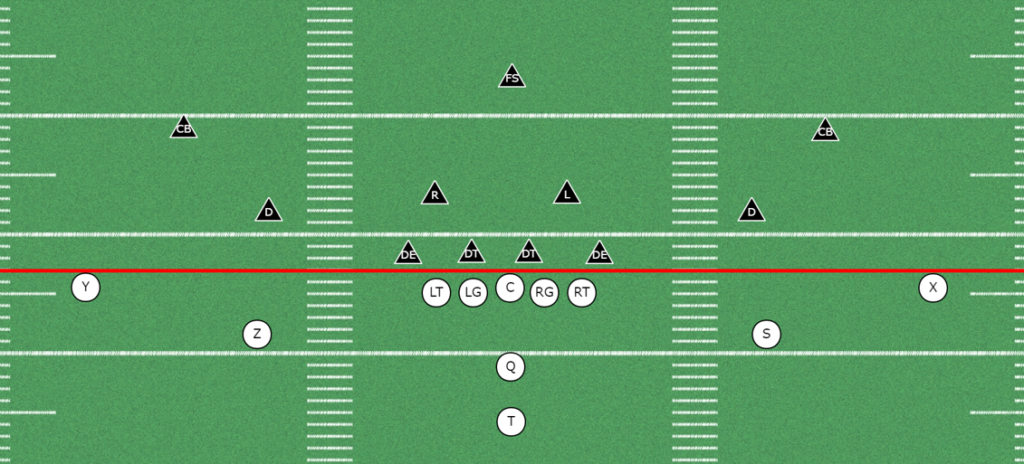
Aligning to a 2×2 formation is very simple for this defense. If the offensive line is balanced, both DEs will line up on the outside shoulder of the tackles. They will be responsible for contain. If you are playing a Zone coverage the CBs (except for Cover 2) will play off and split the different between both receivers. If you are playing man you can move the CBs up in press or you can have them play off man coverage. In man the D’s will cover the inside receivers.
vs. 3×1
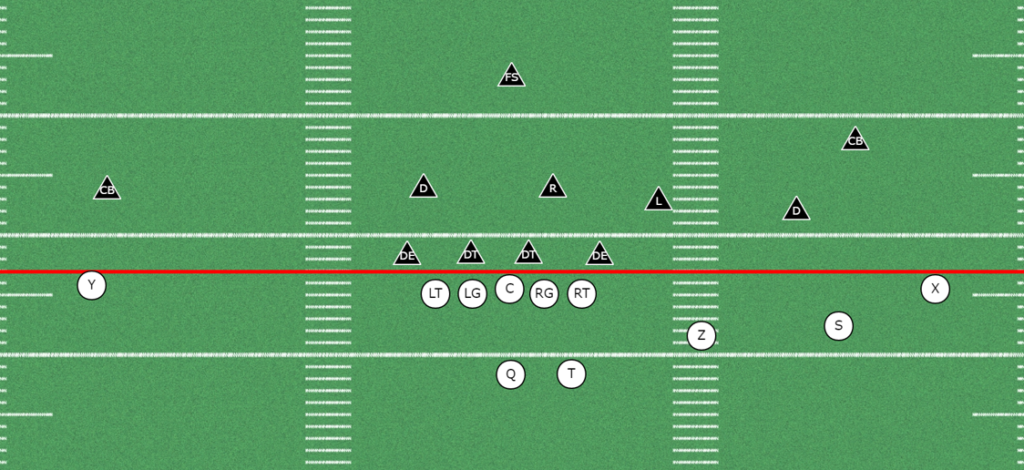
In my opinion, aligning against 3×1 spread is the most challenging. There are several different ways you can handle this formation. The first way is simple and shown on the diagram above. Basically, you just bump the linebackers out to match numbers. You can do several different things with D away from trips. You can have line up like a linebacker and make him a box player. You can keep him in his regular overhang alignment and have him blitz off of the edge. You can also have him move back and have him play safety (good for long down and distances).
vs. 3×1 with 2 Safeties
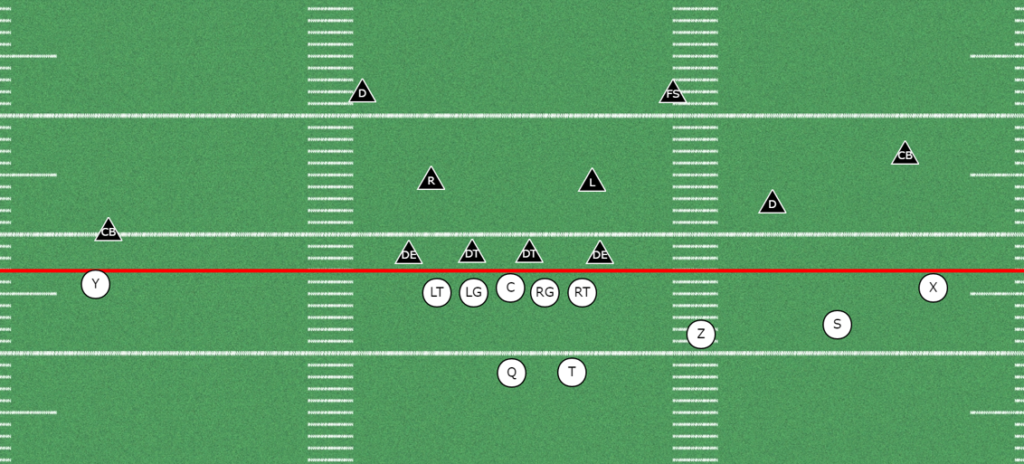
Alignment vs. Compressed Formation
vs. Double TE
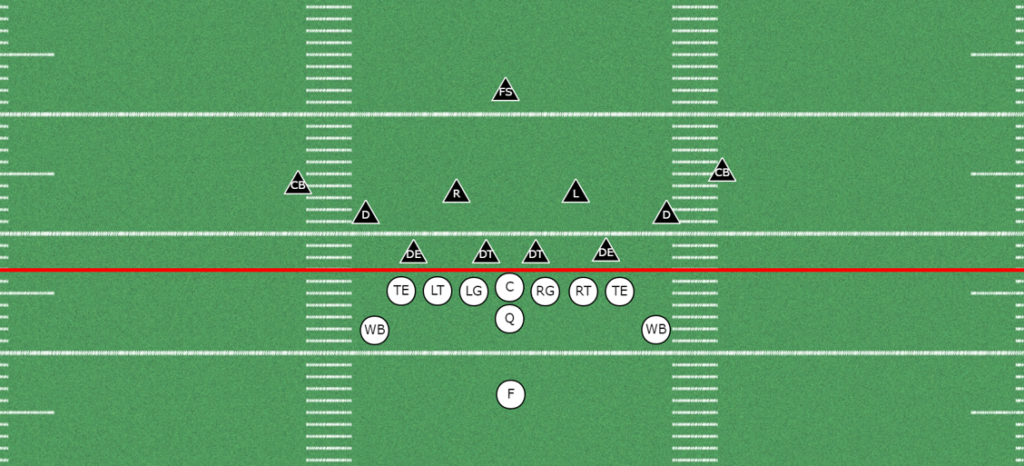
Aligning against compressed formation isn’t very difficult. Against compressed formation like shown above, you really don’t have to worry about getting beat deep on passes- as long as your CBs and Dogs (D) don’t get caught looking at backfield action- key TE to WB. Also, putting your DE on an inside shade of the TE will help slow down any TE release and it will help anchor against any off-tackle plays.
vs. TE/WB Flank
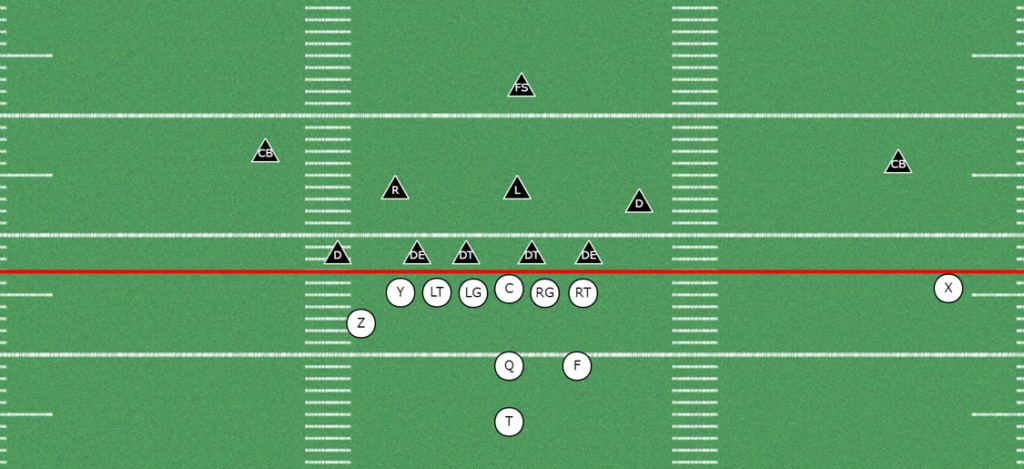
The TE/WB flank is another difficult formation to defend. It presents a heavy run threat and it also gives you 2 passing options on one side- so you have a run strength and a passing strength to the same side. As far as aligning goes, you will treat this as a strong right- the strong side DT will be in a 3 tech and the DE will be in a 7 tech. If you want you can have the linebackers shift to the right. This will bring the D up on the outside shoulder of the Y (tight-end) and now you are a 5 man front. The L and R will shift over one gap. The D away from the shift will compress in, but still maintain his overhang leverage.
In youth football, teams are going to run the rock! So the second most important thing when it comes to understanding the 4-2-5 Defense is defending the run! By maintaining a 6 man box you will always be strong against inside runs. The 4-2-5 Defense is very strong against the Inside Zone. This defense emphasizes defending the middle of the field and spilling the play outside to the overhang players. Basically all the linebackers and safeties work inside to out. In the 4-2-5 Defense you want to spill everything to your athletes that have the outside leverage advantage. There are a variety of different stunts that can be utilize to make sure you spill the play outside to the linebackers/hybrids which in this article we label them (D) Dogs. Committing your defense to being a spill team will only require you to practice one type of defense and keep pursuit paths simple and consistent. Force the ball carrier to your athletes!
See Also: Pursuit Drill for Youth Football
I know in youth football it is all about contain, so don’t get scared at the idea of spilling the play outside. Spilling is essentially forcing the play to a great athlete that already has outside leverage (contain player). This is a great defense for youth football because it takes away space and we all know the best youth football offenses try to get their athletes outside and out in space. In regards to pursuit, it’s important that your players all understand their pursuit lanes! All players (excepts the Dogs) work inside to out, aiming point is the near hip on the running back. When defenders chase laterally, that is when cut back lanes are created. Do the pursuit drill every single practice!
Rip Storm (off-tackle pressure)
The Rip Storm blitz is designed to stop Power, Iso or any other off-tackle play. It’s great against the Outside Zone Scheme as well. This play features a defensive line slant inside, with the D and R blitzing outside. The Slanting DE and DT must dip and rip, then anchor their gap. Make sure they don’t get washed down or take themselves out of the play- they must anchor their gap. The D will maintain outside leverage. This blitz is great against spread formations and compressed Double TE formations.
LEO (inside pressure)
This is a blitz we call LEO. Leo just tells the Leo Linebacker that he is blitzing. This is a simple blitz that has the L blitz the B-gap. This is a great blitz against interior plays like Dive, Trap, or Wedge. It’s important that your L understands that he doesn’t want to show his blitz too early. Once the QB begins his cadence that is when the L should start creeping up to the LOS.
LEO Twist (inside pressure)
Here’s another way you can run the LEO blitz. The DE will dip and rip, slanting through B-gap. The L will show blitz through B-gap pre-snap, then blitz behind the DE (DE goes in front) to the C-gap once the ball is snapped. This is a simple twist stunt that is very difficult for youth offensive linemen to pick up. It’s important that your slanting DE dips and rips and anchors the B-gap. He cannot allow himself to get washed down. If you wanted to run this to the right side it would be called ‘RIP Twist’.
LOOP (outside pressure)
This is an simple blitz we call Loop. This blitz is designed to attack the offense off of the edge. This blitz has the D blitzing off of the edge, playing hard contain- he must turn the play inside. The L will blitz through the RT’s outside shoulder and be a cut back player. The DE end must work through the tight-end (I have labeled as X here) and expand with him when he reach blocks on sweep. He is also a cut back player. I like having the DEs physical on the Tight-ends. This will help disrupt the TE’s block path and it will slow down their release on any passes.
The third aspect when it comes to understanding the 4-2-5 defense is pass coverage. Having all this speed on the field paired along with stunts and blitzes will allow you to get pressure while still being sound against pretty much any passing concept. Against spread formations your defensive ends will give you great edge pressure. This will allow you to get pressure and contain a mobile QB. This is a great defense against teams that like to throw screens (your defenders rally to the player catching the screen). You can play a variety of different coverages- everything from man to man to zone coverage. You can play press man coverage on the outside receivers, which will allow you to do different things with your other defenders.
See Also: Tornado Blitz out of the 4-2-5 Defense
The 4-2-5 Defense gives you the option to go with two safeties or you can just stay in a single high look. Personally, I recommend utilize no more than 3 coverages. For me, we would play a base cover 3 and mix in some man to man coverage. I would also install a cover 4 in prevent situations. Most of the time we will stay in our cover 3 because that is what we do. There are many 4-2-5 defenses that play split-field read coverages. However, I don’t think that is good for the youth football level.
Cover 3
Personally, I love Cover 3. I think it is the best pass coverage for youth football. We love to base our defense in Cover 3 against pretty much any formation. It will give your players simple zone drop rules and it will allow you not to get toasted on play-action. When against spread formations it’s important that the CBs split the difference between the two outside receivers. The Ds will have the flat zone and you can have them collision the inside receivers to throw off their route timing.
Man Free
If you are not a fan of zone coverage you can play man free. The L and R will take the Tailback if he runs to their side. For example, the L will take the T if the T runs a swing pass to his side. If the QB rolls out the DE must contain the QB. The DT will pass rush up the middle. When you are seeing 2×2 your defensive ends need to be on the outside shoulder of the tackles. There is no line strength so they line up with outside leverage on the offensive tackles. They now become your contain players.
Conclusion
Understanding the 4-2-5 Defense and it’s strength and weaknesses is very important. This is a great defense for the youth football level because it can easily align to any formation and it will allow you to be multiple while keeping things simple for your players. This defense is designed to get your athletes on the field and to get all the run plays spilled out to your athletes. This is a defense that is primarily ran on the high school level, however, it can easily be executed on the youth football level. Since this isn’t a common youth football defense, it will give your team a point of difference. It will allows show the offense a defense they never seen before. I hope this article helped! If you have any questions feel free to contact us!

Youth Football Online was created by Coaches Jeff Hemhauser and Vin Sehgal in 2010. Want to contribute content? Contact us if you are interested in contributing content.
All children will learn life lessons from participating in youth football. Join our Movement today.

Copyright ©2023 Youth Football Online. All rights reserved.